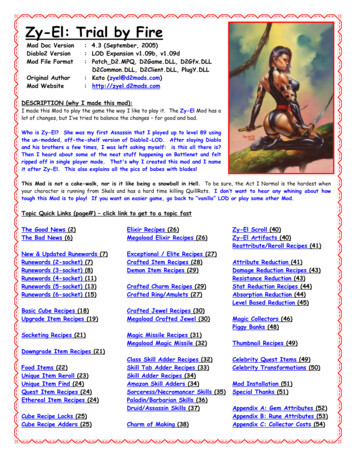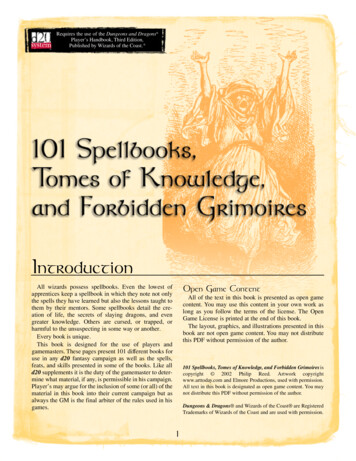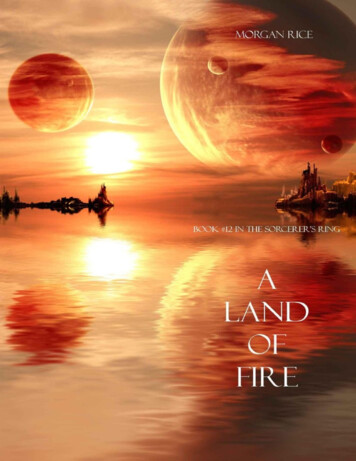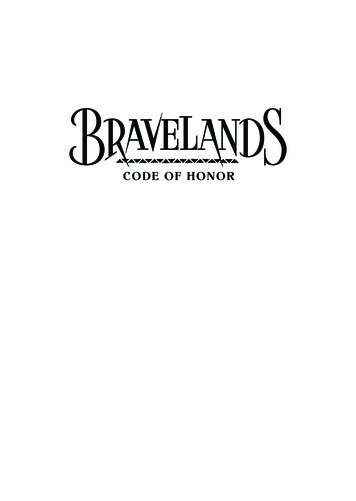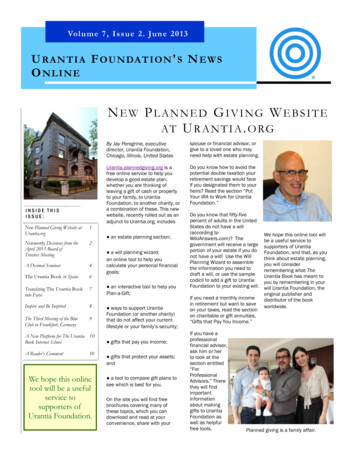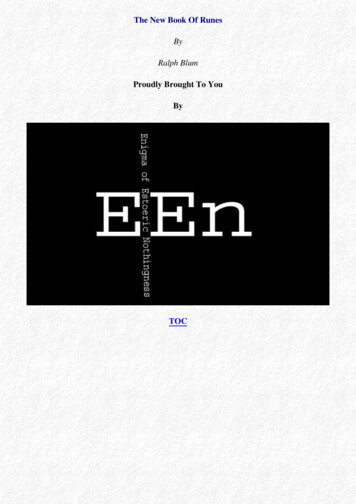
Transcription
The New Book Of RunesByRalph BlumProudly Brought To YouByTOC
The New Book Of RunesByRalph BlumContents:Book Cover (Front)Scan / Edit 1 - The Oracle of the Self2 - The Emergence of the Runes3 - Consulting the OracleConsulting the RunesAppropriate IssuesRunic OverrideUpright and Reversed ReadingsConsulting Two OraclesMaking Your Own RunesLending Your Runes4 - Runemal: The Art of Rune CastingOdin's RuneThree Rune SpreadFive Rune SpreadThe Runic CrossThree Lifetimes SpreadRune PlayThe Cycle of InitiationKeeping a Rune Journal5 - Runecraft: Three New SpreadsWater RunesRunes of RectificationRunes of Comfort for the Bereaved6 - A Destiny Profile7 - Interpreting the Runes8 - Theatre of the SelfAfterword: Magic in the Present TenseSelected Bibliography (Removed)
Pronunciation GuideThe RuneWorks (Removed)
Scan / Edit NotesFormat: v1.5 (PDF - no security)Genera: Divination / RunesExtra's: Pictures IncludedCopyright: 1990 / 1991Scanned: September-18-2002
DedicationThis book is lovingly dedicated to Margaret Mead.
The Viking Runes (read from right to left)The Viking Runes Traditional Meanings
AcknowledgementsFor my introduction to the study of Oracles, I am indebted to Dr Allan W. Anderson, Department ofReligious Studies, San Diego State University. Dr Anderson taught a unique course entitled 'TheOracular Tradition', in which he presented the I Ching as 'the only systematic sacred text we possess'.His scholarship, his presentation of seminal concepts, and his creative influence encouraged me topersevere in my study of 'the finest art of all -the art of self-change'.I am especially grateful to Murray Hope who, on a rainy Wednesday afternoon, in Redhill, Surrey,introduced me to the Runes as a contemporary Oracle.My first attempts at writing this handbook for the use of the Runes as a personal Oracle included anadditional seventy-three pages of history, philology, and archaeology. For support and encouragementin reducing the text to this more concise and manageable form, I gratefully thank my friend andeditor, Bronwyn Jones.Finally, my sincere thanks to Tom Dunne, my editor at St Martin's Press, New York, who has beenunstintingly generous in encouraging me to introduce new insights and techniques into the originaltext.
PrefaceThe Runes as described here are healing, merciful Runes; they will do you no harm. Learn theirlanguage and let them speak to you. Play with the possibility that they can provide 'a mirror for themagic of our Knowing Selves', a means of communication with the knowledge of our subconsciousminds.Remember that you are consulting an Oracle rather than having your fortune told. An Oracle does notgive you instruction as to what to do next, nor does it predict future events. An Oracle points yourattention towards those hidden fears and motivations that will shape your future by their unfeltpresence within each present moment. Once seen and recognized, these elements become absorbedinto the realm of choice. Oracles do not absolve you of the responsibility for selecting your future, butrather direct your attention towards those inner choices that may be the most important elements indetermining that future.How can random selection of marked stones tell you anything about yourself? Perhaps these Runeinterpretations are simply so evocative that each contains some point which can be accepted asrelevant to some part of what is happening at the limits of consciousness any day, any time, to anyone.That is the easiest possibility to accept from a strictly scientific standpoint. Nevertheless, my own playwith these Runes has shown coincidence piled upon coincidence and an apparently consistent'appropriateness' in each Rune reading which is difficult to explain by the mechanism I have justdescribed.Can there be other factors that distort the expected randomness of Rune selection so as to provide alanguage by which the subconscious makes itself and its expectations known? For myself, I maintainan open mind, reminding myself that observations should not be discounted simply because theirunderlying mechanisms have not yet been satisfactorily explained.So go ahead. Try out these Runes. See if this Oracle can mirror your subconscious process, butremember that such a link may take practice to develop. The Rune interpretations offered here comefrom the meditations of a gentle, healing mind. They will speak to you of change and growth. Theonly negativity you will find here relates to the blockage of appropriate growth, while all the positiveaspects are transcendent, transforming and lead to breakthroughs. The subconscious you willencounter here is not a fearsome beast in need of obedience training. It is the inner seeker-after-truthwho must be helped to save us from ourselves.Dr Martin D. RaynerProfessor of PhysiologyUniversity of Hawaii School of Medicine
IntroductionFew people today have even heard the word 'Runes'. Among those of Scandinavian descent andamong readers of Tolkien, yes, a light goes on. But that's about the extent of it. An ancient alphabeticscript, each of whose letters possessed a meaningful name as well as a signifying sound, Runes wereemployed for poetry, for inscriptions and divination, yet never evolved as a spoken language. Next tonothing has been written about the Runes as a contemporary Oracle.Both the alphabetical ordering and the letter interpretations found in The Book of Runes are nonconventional. The interpretations of the Runes as used for divination are lost to us. While legomonism- the passing on of sacred knowledge through initiation - was practised among Rune Masters of old,their secrets were not recorded or, if recorded, did not survive. In ancient times the Runes and theirsymbols were employed by warriors bent on conquest. It is my hope that the Runes, in theircontemporary use, will serve the Spiritual Warrior, the one whose quest is doing battle with the self,the one whose goal is self-change. The Bhagavad Gita in Chapter 6, verse 5, says it succinctly:Lift up the self by the SelfAnd don't let the self droop down,For the Self is the self's only friendAnd the self is the Self's only foe.The Book of Runes has been written as a handbook for the Spiritual Warrior. Free of anxiety,radically alone and unattached to outcomes, the Spiritual Warrior practises absolute trust in thestruggle for awareness, and is constantly mindful that what matters is to have a true present. It takes along time to grow in wisdom, to say nothing of the time it takes to learn to think well. Following theWarrior Way is not for everyone, although it is available to all who are willing to undergo itschallenges. To embark on this path is to cultivate the Witness Self, the Watcher Within, the one whocan profitably converse with the Runes.Before beginning to write, I consulted the Runes about the timeliness of undertaking this work. Thethree Runes drawn were Inguz, the Rune of Fertility and New Beginnings; Nauthiz, the Rune ofNecessity, Constraint and Pain; and Dagaz, the Rune of Breakthrough and Transformation. The Bookof Runes was conceived in one fertile sleepless night. The constraint required during the long hoursspent in editing and reworking the first half of the book was certainly not without pain.---[*] Throughout The Book of Runes, the term self is used to represent the little self or ego-self, andSelf to signify the Higher Self, the God Within.---Yet through it all, I remained mindful of the French saying, Tain is the craft entering into theapprentice.' Working with the Runes has been a source of transformation in my own life and, throughtheir introduction to the Runes, the lives of many others.
All along the way, since beginning this book, there have been positive signs and omens. The final signcame as I completed the Afterword. Since the last Rune Masters lived in seventeenth-century Iceland,it seemed to me fitting to close with an Icelandic blessing. In order to check the spelling of Gud blessithig, the Icelandic for 'God bless you', I placed a call to the Icelandic Consulate in New York. Thewoman who answered confirmed the spelling. When she heard about The Book of Runes, she pauseda long moment, then said, 'My name is Sigrun. It means "Rune of Victory".'During the years since this book was first published, a number of new techniques have suggestedthemselves. Certain of these are now being included in this revised and expanded edition of The Bookof Runes.The Five Rune Spread (p. 53) is helpful when you need to go deeply into an issue, to see it illuminatedfrom several different perspectives. Runes of Rectification, Water Runes, and Runes of Comfort forthe Bereaved, first presented in somewhat different form in Rune Play (Michael Joseph, London,1987), are here grouped in the chapter entitled Runecraft: Three New Spreads (p. 67). A DestinyProfile, 'a grid within which a human life can be framed', stands in a chapter on its own (p. 74). Forthe many people who have written to ask about the pronunciation of the old Germanic Rune names, apronunciation guide is now included (p. 150).As time goes on, other techniques and practices may be added to the original text since functiondetermines form, use confers meaning, and an Oracle always resonates to the requirements of the timein which it is consulted.InvocationGod within me, God without,How shall I ever be in doubt?There is no place where I may goAnd not there see God's face, not knowI am God's vision and God's ears.So through the harvest of my yearsI am the Sower and the Sown,God's Self unfolding and God's own.
Rune stone, Vasterby, Uppland, Sweden, work of Asmund Karasun, c. AD 1050
1 - The Oracle Of The SelfA King he was on a carven throneIn many-pillared halls of stoneWith golden roof and silver floor,And runes of power upon the door.J.R.R. TolkienThe Fellowship of the RingRunes and charms are very practical formulae designedto produce definite results, such as getting a cow out of a bog.T.S. EliotThe Music of PoetryThe purpose of this book is to reintroduce an ancient Oracle, the Runes. Older than the NewTestament, the Runes have lain fallow for more than 300 years. Akin in function to the Tarot and theChinese Book of Changes, the Runes were last in current use in Iceland during the late Middle Ages.In their time they served as the I Ching of the Vikings.The wisdom of the Rune Masters died with them. Nothing remains but the sagas, the far-flungfragments of runic lore and the Runes themselves. In his fine book, Runes: An Introduction, RalphW.V. Elliott writes of strange symbols scratched into ancient tools and weapons now lying idle insome museum showcase; names of warriors, secret spells, even snatches of songs, appearing onobjects as diverse as minute silver coins and towering stone crosses, scattered in the unlikeliest placesfrom Yugoslavia to Orkney, from Greenland to Greece. (*)The influence of the Runes on their time is incontestable. Elliott notes that when the high chieftainsand wise counsellors of Anglo-Saxon England met in conclave, they called their secret deliberations'runes', and that when Bishop Wulfila made his translation of the Bible into fourth-century Gothic, herendered St Mark's 'the mystery of the kingdom of God' (Mark 4:11) using runa, for the word'mystery'.Eight centuries earlier, when the Greek historian Herodotus travelled around the Black Sea, heencountered descendants of Scythian tribesmen who crawled under blankets, smoked themselves intoa stupor (a practice still encountered even today in the Caucasus Mountains) and then cast sticks in the
air and 'read' them when they fell Although these tribesmen were pre-literate, their sticks wouldprobably qualify as Runes.---[*] Ralph W V. Elliott, Runes An Introduction (Manchester University Press, 1959), p. 1.]---There is no firm agreement among scholars as to where and when runic writing first made itsappearance in Western Europe. (*)Before the Germanic peoples possessed any form of script, they used pictorial symbols that theyscratched onto rocks. Especially common in Sweden, these prehistoric rock carvings or hallristningarare dated from the second Bronze Age (c. 1300 BC), and were probably linked to Indo-Europeanfertility and SUM cults. The carvings include representations of men and animals, parts of the humanbody, weapon motifs, sun symbols, the swastika and variations on square and circular forms:Elliott suggests an amalgamation of two separate traditions, 'the alphabetic script on the one hand, thesymbolic content on the other . The practice of sortilege (divination) was cultivated among NorthernItalic as well as Germanic peoples, the one using letters, the others pictorial symbols.' (** )Numerous hallristningar; as well as the runic standing stones, can still be seen in the British Isles, inGermany, and throughout Scandinavia.---[*] Elliott writes: 'All we know then is that in some Germanic tribe some man had both the leisure (afactor often forgotten) and the remarkable phonetic sense to catch the futhark (alphabetic script) froma North Italic model known to him somewhere in the alpine regions in the period c. 250-150 B.C.' Op.cit., p. 11.][**] [Elliott, op cit, pp. 64-5]---It is difficult for us to imagine the immense powers bestowed on the few who became skilled in theuse of symbolic markings or glyphs to convey thought. Those first glyphs were called runes, from theGothic runa, meaning 'a secret thing, a mystery'. The runic letter, or runastafr, became a repository for
intuitions that were enriched according to the skill of the practitioner of runemal, the art of Runecasting.From the beginning, the Runes took on a ritual function, serving for the casting of lots, for divinationand to evoke higher powers that could influence the lives and fortunes of the people. The craft ofrunemal touched every aspect of life, from the most sacred to the most practical. There were Runesand spells to influence the weather, the tides, crops, love, healing; Runes of fertility, cursing andremoving curses, birth and death. Runes were carved on amulets, drinking cups, battle spears, over thelintels of dwellings and onto the prows of Viking ships.The Runecasters of the Teutons and Vikings wore startling garb that made them easily recognizable.Honoured, welcomed, feared, these shamans were familiar figures in tribal circles. There is evidencethat a fair number of runic practitioners were women. The anonymous author of the thirteenth-centurySaga of Erik the Red provides a vivid description of a contemporary mistress of runecraft:She wore a cloak set with stones along the hem. Around her neck and covering her head she wore ahood lined with white catskins. In one hand she carried a staff with a knob on the end and at her belt,holding together her long dress, hung a charm pouch.To pre-Christian eyes, the earth and all created things were alive. Twigs and stones served for runicdivination since, as natural objects, they embodied sacred powers. Runic symbols were carved intopieces of hardwood, incised on metal or cut into leather that was then stained with pigment into whichhuman blood was sometimes mixed to enhance the potency of the spell. The most common Runeswere smooth flat pebbles with symbols or glyphs painted on one side. The practitioners of runemalwould shake their pouch and scatter the pebbles on the ground; those falling with glyphs upward werethen interpreted.The most explicit surviving description of this procedure comes from the Roman historian Tacitus.Writing in AD 99 about practices prevalent among the Germanic tribes, he reports:To divination and casting of lots they pay attention beyond any other people. Their method of castinglots is a simple one: they cut a branch from a fruit-bearing tree and divide it into small pieces whichthey mark with certain distinctive signs (notae) and scatter at random onto a white cloth.Then, the priest of the community, if the lots are consulted publicly, or the father of the family, if it isdone privately, after invoking the gods and with eyes raised to heaven, picks up three pieces, one at atime, and interprets them according to the signs previously marked upon them.(Germania, Ch. X)By Tacitus' time, the Runes were already becoming widely known on the Continent. They werecarried from place to place by traders, adventurers, and warriors and, eventually, by Anglo-Saxonmissionaries. For this to happen, a common alphabet was required - the alphabet that became knownas futhark after its first six letters or glyphs:
Although later Anglo-Saxon alphabets expanded to include as many as thirty-three letters in Britain,the traditional Germanic futhark is comprised of twenty-four Runes. These were divided into three'families' of eight Runes, three and eight being numbers credited with special potency. The threegroups, known as aettir, were named for the Norse gods Freyr, Hagal and Tyr. The three aettir are:It is with these twenty-four Runes, plus one later innovation, a Blank Rune, that The Book of Runes isconcerned.The Rune Of HospitalityI saw a stranger yestereen;I put food in the eating place,Drink in the drinking place,Music in the listening place;And in the sacred names of the TriuneHe blessed me and my house,My cattle and my dear ones.And the lark said in her song:Often, often, often,Goes the Christ in the stranger's guise:Often, often, often,Goes the Christ in the stranger's guise.
From the GaelicChrist figure, Jaellinge, Denmark, c. AD 980
2 - The Emergence Of The RunesOracle, from the Latin oraculum, divine announcement. 1. among the ancient Greeks and Romans,a) the place where, or medium by which, deities were consulted; b) the revelation or response of amedium or priest; 2. a) any person or agency believed to be in communication with a deity; b) anyperson of great knowledge or wisdom; c) opinions or statements of any such oracle; 3 the holy ofholies of the ancient Jewish Temple.Webster's New World DictionaryAnd the oracle he prepared in the house within, to set there the ark of the covenant of the LordI Kings 6:19When I began to work with the Runes, I had never seen a runic text and, therefore, did not realize thatI was breaking away from the traditional sequence of Freyr, Hagal and Tyr used by the earlypractitioners of runemal. But function determines form, use confers meaning and an Oracle alwaysresonates to the requirements of the time in which it is consulted. I had to rely on the Runes toestablish their own order and to instruct me in their meanings.The Rune stones I was working with had come to me in England: tiny brown rectangles hardly biggerthan a thumbnail, with the glyphs scratched into the surfaces. The woman who made them lived inTrindles Road, Redhill, Surrey. She hadn't glazed her Runes, merely baked them in her oven likebiscuits.Along with this set of Runes came two Xeroxed sheets giving the glyphs their approximate Englishmeaning and a brief interpretation for each Rune when 'Upright' or 'Reversed'. To the twenty-fouroriginal Runes had been added a Blank Rune represented simply as 'The path of karma: That which ispredestined and cannot be avoided. Matters hidden by the gods.' There were no instructions for usingthe Runes and, after a few days, the Trindles Road Runes went onto a shelf.But I kept the Runes and took them back to the United States. Several years passed before I happenedupon them again. I was alone on my Connecticut farm. It was a warm summer evening and I couldn'tsleep, so I went to my study and began rearranging books. And there, in their little chamois bag, werethe Runes.As I emptied the stones out onto my desk and moved them around, I experienced the same pleasurable
feeling that I had when I first handled them in England. It was then that it occurred to me to ask theRunes how they were to be used. I sat quietly for a time, composing myself, and said a prayer. Iopened my notebook and wrote out this question: 'In what order do you wish to be arranged?' I notedthe time, 10.55 p.m., and the date, 21 June - the night of the summer solstice?I spread out the Runes, blank sides up, and moved them around, touching each stone. Then, one byone, I turned them over, aligning them in front of me in three rows. It took only a few moments. WhenI was done, I sat and studied the arrangement:I remember my first feeling was dismay that the Blank Rune, the Rune of the Unknown, had notpositioned itself more dramatically, rather than simply taking its place among Arrest. And then I gotan eerie feeling: I had been told that the Runes could be read from right to left. (*) Seen that way, thesequence began with the Rune of 'The Self, Mannaz , and ended with the Blank Rune, the Rune thatsignals the presence of the Divine in our lives.It was while I sat gazing at the Rune of 'The Self that these words came to me:The starting point is the self. Its essence is water. Only clarity, willingness to change, is effective now.---[*] The Runes could face either way and be read from left or right or, on occasion, vertically Someinscriptions even read boustrephedon, from the Greek bous, an ox, and strophe, to turn, meaning thepattern in which a field is ploughed with oxen See illustration on p 37---The Viking Runes had begun their teaching.I worked on through the night, taking each Rune in my hand, sitting with it, meditating on it, writingdown what came to me. Now and then, when the flow dwindled, I turned to the I Ching. and asked fora hexagram that would reveal the essence of a particular Rune. The spirit of some of those readings isincorporated into the interpretations of the Viking Runes. By the time I had completed the
interpretation of the Blank Rune, the sun was rising.Since that night, I have read a great deal about the Runes and their history, the controversies over theirorigins, the speculations concerning their use. Only one thing is certain: beyond all the efforts ofscholars to encompass them, the Runes remain elusive, for they are Odin's gift, and sacred.Odin is the principal divinity in the pantheon of Norse gods. His name derives from the Old Norse for'wind' and 'spirit', and it was through his passion, his transforming sacrifice of the self, that Odinbrought us the Runes. According to legend, he hung for nine nights on the Yggdrasil, the Tree of theWorld, wounded by his own blade, tormented by hunger, thirst and pain, unaided and alone until,before he fell, he spied the Runes and, with a last tremendous effort, seized them.Next to the gift of fire, that of the alphabet is the light in which we see our nature revealed. In ThePoetic Edda, Odin, the great Rune Master, speaks across the centuries. Hear Odin now:Do you know how to cut them, know how to stain them,Know how to read them, how to understand?Do you know how to evoke them, know how to send them,Know how to offer, know how to ask?It is better not to offer than to offer too much for a gift demands a gift,Better not to slay than to slay too many.Thus did Odin speak before the earth began when he rose up in after time.These runes I know, unknown to kings' wivesOr any earthly man. 'Help' one is called,For help is its gift, and helped you will beIn sickness and care and sorrow.Another I know, which all will needWho would study leechcraft.On the bark scratch them, on the bole of treesWhose boughs bend to the east.I know a third If my need be great in battleIt dulls the swords of deadly foes,Neither wiles nor weapons wound meAnd I go all unscathed .So begins the sacred history of the Runes.The motto for the Runes could be the same words that were carved above the gate of the Oracle atDelphi: Know thyself The Runes are a teacher. Yet for some it may be more comfortable to approachthe Runes in the spirit of play. Oracles are sacred games, instruments for serious or high play, and the
value of play is that it frees us from the effort of learning, frees us to learn as children learn. The Bookof Runes is offered as a primer for oracular play.Each of us is an Oracle, and when we pray we are exercising our true oracular function, which is toconsult the Knowing Self within. Consulting the Runes will put you in touch with your own innerguidance, with the part of you that knows everything you need to know for your life now.One prominent modern authority for the efficacy of Oracles is the Swiss psychologist Carl Jung. Jungaffirmed that 'theoretical considerations of cause and effect often look pale and dusty in comparison tothe practical results of chance'. (*) This suggests that nothing is too insignificant to be regarded as aclue to guide us in right and timely action. Consulting an Oracle places you in true present timebecause whatever happens in the given moment possesses what Jung calls 'the quality peculiar to thatmoment'.---[*] C.G. Jung, Foreword to the / Ching (Princeton, N.J.: Princeton University Press, 1950).---Experiencing a true present is something most of us find extremely difficult. We waste a good part ofour lives dwelling on past regrets and fantasizing on future disasters. In my own life, when I jog ordrive long distances, I am often busy reviewing ideas, thinking out schemes, going over options andopportunities. Suddenly I catch myself: I realize that miles of countryside have slipped by unseen, thatI am not aware of breathing the air, not aware of the trees, the breeze, the ruts in the road. Nowadays,I catch myself more and more frequently, which is a beginning. The 'roof-brain chatter' is slowlybeing replaced with a stillness that keeps me in the now. Once the momentum is broken, the habit willsoon wither. I have only to remember: In the spiritual life, we are always at the beginning.Remembering this helps us to overcome our addiction to 'getting ahead'. For when we experience atrue present, that is where everything happens.Consulting the Runes enables you to bypass the strictures of reason, the fetters of conditioning and themomentum of habit. (*) For the brief span of interacting with the Runes you are declaring a free zonein which your life is malleable, vulnerable, and open to change.---[*] As Brugh Joy reminds us in his useful guidebook, Joy's Way A Map for the Transitional Journey(Los Angeles: J.P. Tarcher, Inc., 1979), there are three sets of mental fetters to give up if you want tobe truly free: judging, comparing and needing to know why. The 'why' inevitably becomes clear asyou progress in your passage.---We are living in an age of radical discontinuity. The lessons come faster and faster as our souls and
the universe push us into new growth. Familiar waters seem suddenly perilous, alive with unchartedshoals and shifting sandbars. The old maps are outdated; we require new navigational aids. And theinescapable fact is: You are your own cartographer now. Just as the Vikings used the informationprovided by the Rune Masters to navigate their ships under cloudy skies, so now you can use theRunes to modify your own life course. A shift of a few degrees at the beginning of any voyage willmean a vastly different position far out to sea.Whatever the Runes maybe - a bridge between the self and the Self, a link between the Self and theDivine, a ageless navigational aid the energy that engages them is our own and, ultimately, thewisdom as well. Thus, as we start to make contact with our Knowing Selves, we will begin to hearmessages of profound beauty and true usefulness. For like snowflakes and fingerprints, each of ouroracular signatures is a one-of-a-kind aspect of Creation addressing its own.CredoThe truth is that life is hard and dangerous; that he who seeks his own happiness does not find it; thathe who is weak must suffer; that he who demands love will be disappointed; that he who is greedy willnot be fed; that he who seeks peace will find strife; that truth is only for the brave; that joy is only forhim who does not fear to be alone; that life is only for the one who is not afraid to die.Joyce Gary
Boustrephedon script on stone near Asferg, Sweden
3 - Consulting The OracleThe real voyage of discovery consists not in seeking new landscapes but in having new eyes.Marcel ProustLord, grant me weak eyes for things that are of no account and strong eyes for all thy truth.Soren KierkegaardWe walk by faith and not by sight.St PaulOnce you start exploring the world of Runes, you will discover that many people have developed theirown form of personal Rune casting. There is a man who works the boardwalk in Venice, California.He sits on an old sheet on which he has painted the rainbow circles of a bull's eye eye. He has a bag ofstones, shells and twigs, and when you have posed your question he scatters his 'Runes' and readsfrom their read. There are people who work with sand dollars (flats sea urchin shells), bits of bone, orstones upon which they have scratched their own symbols.Then there is what one of my friends calls 'Noah Webster's Oracle'. He opens the dictionary atrandom, taking his counsel from the words to 'which his finger points. At one moment, while workingintensively on this book, I was presented with an attractive business opportunity that I felt obliged topass up, in doing so, I feared I was missing out and I began giving myself a hard time. Instead ofconsulting the Runes on this issue, I opened a dictionary and, without looking, set my finger on thepage. The counsel I received came under the words lay off, and contained, beneath my finger, thephrases, 'mark off boundaries . stop criticizing . minimize risk'. I returned to the manuscript with aclear conscience. Over the years, I have met a number of people who, without any precise knowledgeof Oracles, employ the Bible in a similar fashion. These contemporary Oracles are consistent withancient traditions - such as the Chinese practice of reading oracle bones or the cracks that appear ontortoise shells when heated in a fire - and with the practice of runemal itself.While working
The Book of Runes has been written as a handbook for the Spiritual Warrior. Free of anxiety, radically alone and unattached to outcomes, the Spiritual Warrior practises absolute trust in the

